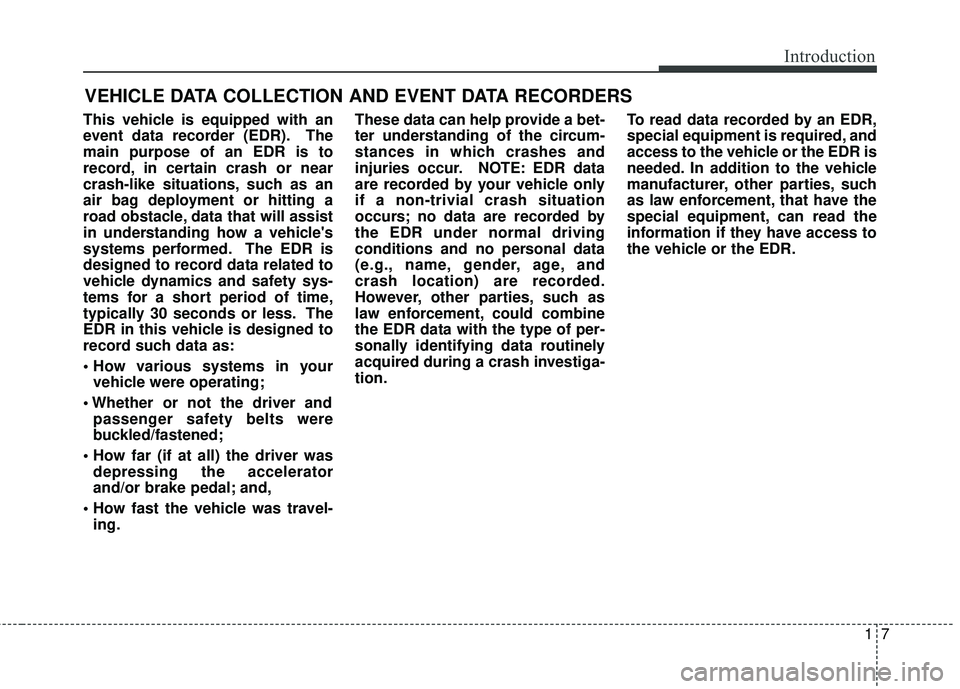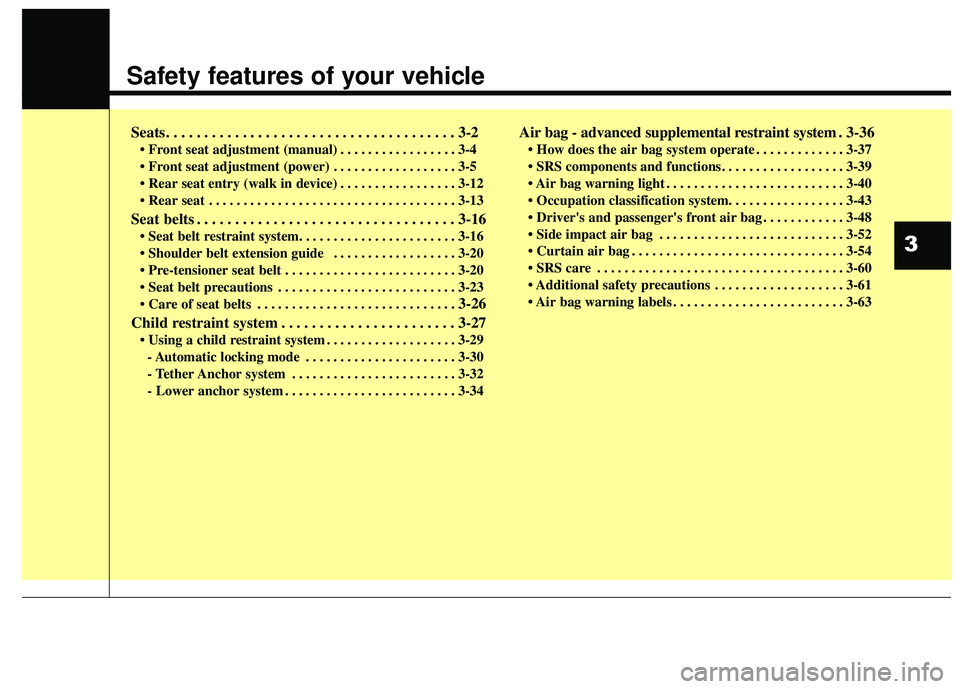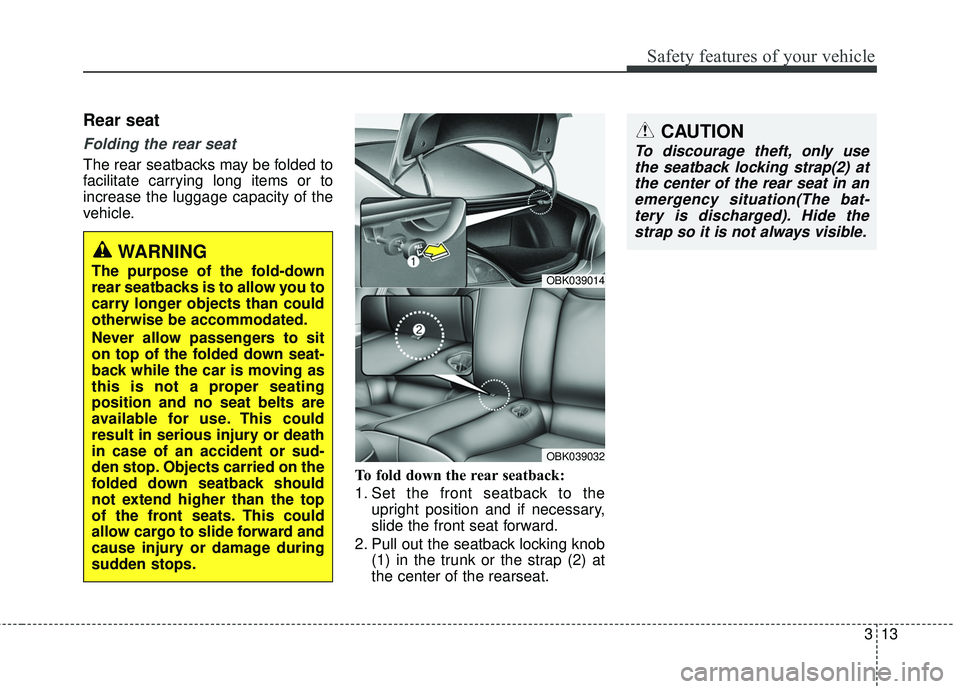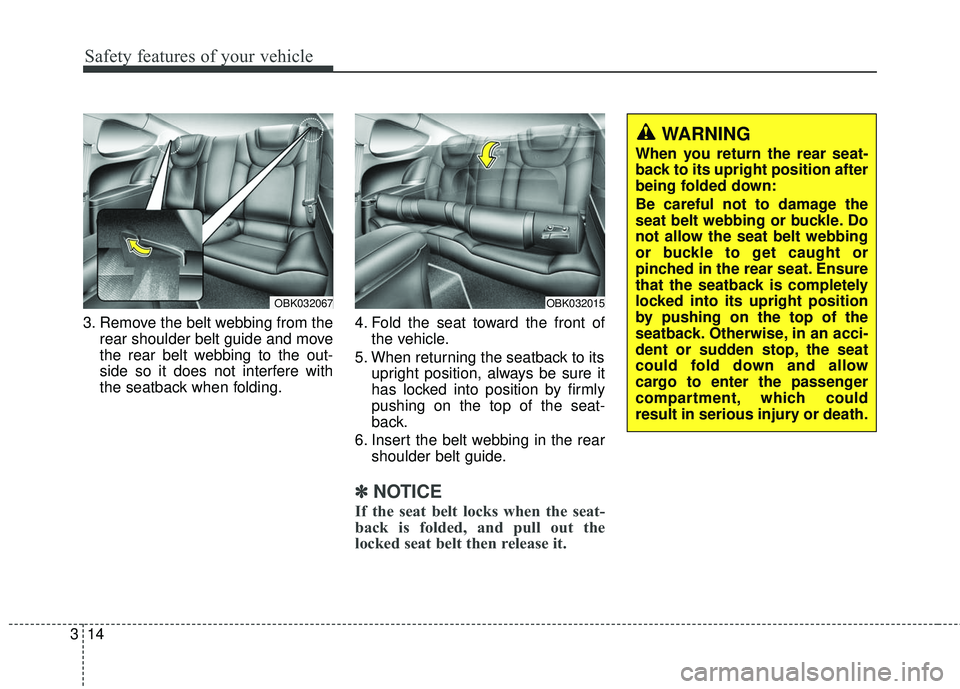2016 HYUNDAI GENESIS COUPE ULTIMATE belt
[x] Cancel search: beltPage 7 of 475

1
2
3
4
5
6
7
8I
IntroductionHow to use this manual / Fuel requirements / Vehicle break-in process / Vehicle data collection and event data recorders / Indicator symbols on t\
he instrument cluster
Your vehicle at a glance
Exterior overview / Interior overview / Instrument panel overview / Engi\
ne compartment
Safety features of your vehicle
Seats / Seat belts / Child restraint system / Air bag
Features of your vehicleKeys / Door locks / Trunk / Windows / Hood / Fuel filler lid / Sunroof / Steering wheel / Mirrors /
Instrument cluster / Multigauge / Lighting / Wipers & Washers / Climate control system / Etc.
Driving your vehicleBefore driving / Engine start/stop button / Transmission / Brake system / Cruise control system /
Winter driving / Vehicle load limit / Etc.
What to do in an emergencyRoad warning / Emergency while driving / Emergency starting / Engine overheat / TPMS / Flat tire / Towing / Etc.
MaintenanceEngine compartment / Maintenance service / Engine oil / Engine coolant /\
Brake fluid / Washer fluid /
Parking brake / Air cleaner / Wiper blades / Battery / Tire and wheels / Fuses / Light bulbs / Etc.
Specifications, Consumer information and Reporting safety defects
Index
table of contents
Page 14 of 475

17
Introduction
This vehicle is equipped with an
event data recorder (EDR). The
main purpose of an EDR is to
record, in certain crash or near
crash-like situations, such as an
air bag deployment or hitting a
road obstacle, data that will assist
in understanding how a vehicle's
systems performed. The EDR is
designed to record data related to
vehicle dynamics and safety sys-
tems for a short period of time,
typically 30 seconds or less. The
EDR in this vehicle is designed to
record such data as:
vehicle were operating;
passenger safety belts were
buckled/fastened;
depressing the accelerator
and/or brake pedal; and,
ing. These data can help provide a bet-
ter understanding of the circum-
stances in which crashes and
injuries occur. NOTE: EDR data
are recorded by your vehicle only
if a non-trivial crash situation
occurs; no data are recorded by
the EDR under normal driving
conditions and no personal data
(e.g., name, gender, age, and
crash location) are recorded.
However, other parties, such as
law enforcement, could combine
the EDR data with the type of per-
sonally identifying data routinely
acquired during a crash investiga-
tion.
To read data recorded by an EDR,
special equipment is required, and
access to the vehicle or the EDR is
needed. In addition to the vehicle
manufacturer, other parties, such
as law enforcement, that have the
special equipment, can read the
information if they have access to
the vehicle or the EDR.
VEHICLE DATA COLLECTION AND EVENT DATA RECORDERS
Page 21 of 475

Safety features of your vehicle
Seats. . . . . . . . . . . . . . . . . . . . . . . . . . . . . . . . . . . . \
. . 3-2
• Front seat adjustment (manual) . . . . . . . . . . . . . . . . . 3-4
. . . . . . . . . . . . . . . . . . 3-5
. . . . . . . . . . . . . . . . . 3-12
. . . . . . . . . . . . . . . . . . . . . . . . . . . . . . . . . . . . \
3-13
Seat belts . . . . . . . . . . . . . . . . . . . . . . . . . . . . . . . . . . 3-16\
. . . . . . . . . . . . . . . . . . 3-20
. . . . . . . . . . . . . . . . . . . . . . . . . 3-20
. . . . . . . . . . . . . . . . . . . . . . . . . . 3-23
. . . . . . . . . . . . . . . . . . . . . . . . . . . . .
3-26
Child restraint system . . . . . . . . . . . . . . . . . . . . . . . 3-27
. . . . . . . . . . . . . . . . . . . 3-29 - Automatic locking mode . . . . . . . . . . . . . . . . . . . . . . 3-30
- Tether Anchor system . . . . . . . . . . . . . . . . . . . . . . . . 3-32
- Lower anchor system . . . . . . . . . . . . . . . . . . . . . . . . . 3-34
Air bag - advanced supplemental restraint system . 3-36
. . . . . . . . . . . . . 3-37
. . . . . . . . . . . . . . . . . . . . . . . . . . 3-40
. . . . . . . . . . . . 3-48
. . . . . . . . . . . . . . . . . . . . . . . . . . . 3-52
. . . . . . . . . . . . . . . . . . . . . . . . . . . . . . . 3-54
. . . . . . . . . . . . . . . . . . . . . . . . . . . . . . . . . . . . \
3-60
. . . . . . . . . . . . . . . . . . . 3-61
. . . . . . . . . . . . . . . . . . . . . . . . . 3-63
3
Page 23 of 475

33
Safety features of your vehicle
WARNING- Driver’s seat
Never attempt to adjust the seat while the vehicle is mov-
ing. This could result in loss of
control, and an accident caus-
ing death, serious injury, or
property damage.
Do not allow anything to inter- fere with the normal position
of the seatback. Storing items
against a seatback or in any
other way interfering with
proper locking of a seatback
could result in serious or fatal
injury in a sudden stop or col-
lision.
Always drive and ride with your seatback upright and the lap
portion of the seat belt snug
and low across the hips. This
is the best position to protect
you in case of an accident.
(Continued)WARNING- Loose
objects
Loose objects in the driver’s
foot area could interfere with
the operation of the foot pedals,
possibly causing an accident.
Do not place anything under the
front seats.WARNING- Driver
responsibility for passen-
gers
Riding in a vehicle with the
seatback reclined could lead to
serious or fatal injury in an acci-
dent. If a seat is reclined during
an accident, the occupant’s
hips may slide under the lap
portion of the seat belt applying
great force to the unprotected
abdomen. Serious or fatal inter-
nal injuries could result. The
driver must advise the passen-
ger to keep the seatback in an
upright position whenever the
vehicle is in motion.
WARNING - Uprighting
seat
When you return the seatback
to its upright position, hold the
seatback return it slowly and be
sure there are no other occu-
pants around the seat. If the
seatback is returned without
being held and controlled, the
back of the seat could spring
forward resulting in accidental
injury to a person struck by the
seatback.
WARNING
Do not use a sitting cushion that
reduces friction between the
seat and passenger. The passen-
ger's hips may slide under the
lap portion of the seat belt dur-
ing an accident or a sudden
stop. Serious or fatal internal
injuries could result because the
seat belt can't operate normally.
Page 33 of 475

313
Safety features of your vehicle
Rear seat
Folding the rear seat
The rear seatbacks may be folded to
facilitate carrying long items or to
increase the luggage capacity of the
vehicle.To fold down the rear seatback:
1. Set the front seatback to theupright position and if necessary,
slide the front seat forward.
2. Pull out the seatback locking knob (1) in the trunk or the strap (2) at
the center of the rearseat.
WARNING
The purpose of the fold-down
rear seatbacks is to allow you to
carry longer objects than could
otherwise be accommodated.
Never allow passengers to sit
on top of the folded down seat-
back while the car is moving as
this is not a proper seating
position and no seat belts are
available for use. This could
result in serious injury or death
in case of an accident or sud-
den stop. Objects carried on the
folded down seatback should
not extend higher than the top
of the front seats. This could
allow cargo to slide forward and
cause injury or damage during
sudden stops.OBK039014
OBK039032
CAUTION
To discourage theft, only usethe seatback locking strap(2) atthe center of the rear seat in anemergency situation(The bat-tery is discharged). Hide thestrap so it is not always visible.
Page 34 of 475

Safety features of your vehicle
14
3
3. Remove the belt webbing from the
rear shoulder belt guide and move
the rear belt webbing to the out-
side so it does not interfere with
the seatback when folding. 4. Fold the seat toward the front of
the vehicle.
5. When returning the seatback to its upright position, always be sure it
has locked into position by firmly
pushing on the top of the seat-
back.
6. Insert the belt webbing in the rear shoulder belt guide.
✽ ✽NOTICE
If the seat belt locks when the seat-
back is folded, and pull out the
locked seat belt then release it.
OBK032015OBK032067
WARNING
When you return the rear seat-
back to its upright position after
being folded down:
Be careful not to damage the
seat belt webbing or buckle. Do
not allow the seat belt webbing
or buckle to get caught or
pinched in the rear seat. Ensure
that the seatback is completely
locked into its upright position
by pushing on the top of the
seatback. Otherwise, in an acci-
dent or sudden stop, the seat
could fold down and allow
cargo to enter the passenger
compartment, which could
result in serious injury or death.
Page 35 of 475

315
Safety features of your vehicle
WARNING- Cargo
Cargo should always be
secured to prevent it from being
thrown about the vehicle in a
collision and causing injury to
the vehicle occupants. Do not
place objects on the rear seats,
since they cannot be properly
secured and may hit the front
seat occupants in a collision.WARNING - Rear seat
belts
When returning the rear seat- backs to the upright position,
remember to return the rear
shoulder belts to their proper
position.
After returning the rear seat- backs to the upright position,
check that the rear seats are
secure.
WARNING - Cargo load-
ing
Make sure the engine is off, the
automatic transmission is in P
(Park) or the manual transmis-
sion is in reverse, and the park-
ing brake is securely applied
whenever loading or unloading
cargo. Failure to take these
steps may allow the vehicle to
move if the shift lever is inad-
vertently moved to another
position.
Page 36 of 475

Safety features of your vehicle
16
3
Seat belt restraint system
SEAT BELTS
WARNING
Seat belts are designed to bear
upon the bony structure of the
body, and should be worn low
across the front of the pelvis, or
the pelvis, chest and shoulders,
as applicable; wearing the lap
section of the belt across the
abdominal area must be avoided.
Seat belts should be adjusted
as firmly as possible, consis-
tent with comfort, to provide the
protection for which they have
been designed.
(Continued)
(Continued)
A slack belt will greatly reduce
the protection afforded to the
wearer.
Care should be taken to avoid
contamination of the webbing
with polishes, oils and chemi-
cals and particularly battery
acid. Cleaning may safely be
carried out using mild soap and
water. The belt should be
replaced if webbing becomes
frayed, contaminated or dam-
aged. It is essential to replace
the entire assembly after it has
been worn in a severe impact
even if damage to the assembly
is not obvious. Belts should not
be worn with straps twisted.
Each seat belt assembly must
only be used by one occupant;
it is dangerous to put a belt
around a child being carried on
the occupant's lap.(Continued)
Avoid wearing twisted seatbelts. A twisted belt can't do
its job as well. In a collision, it
could even cut into you. Be
sure the belt webbing is
straight and not twisted.
Be careful not to damage the belt webbing or hardware. If
the belt webbing or hardware
is damaged, replace it.
WARNING
For maximum restraint systemprotection, the seat belts must
always be used whenever the
car is moving.
Seat belts are most effective when seatbacks are in the
upright position.
Children age 12 and under must always be properly
restrained in the rear seat.
Never allow children to ride in
the front passenger seat. If a
child over 12 must be seated in
the front seat, he/she must be
properly belted and the seat
should be moved as far back as
possible.
Never wear the shoulder belt under your arm or behind your
back. An improperly posi-
tioned shoulder belt can cause
serious injuries in a crash. The
shoulder belt should be posi-
tioned midway over your shoul-
der across your collarbone.
(Continued)